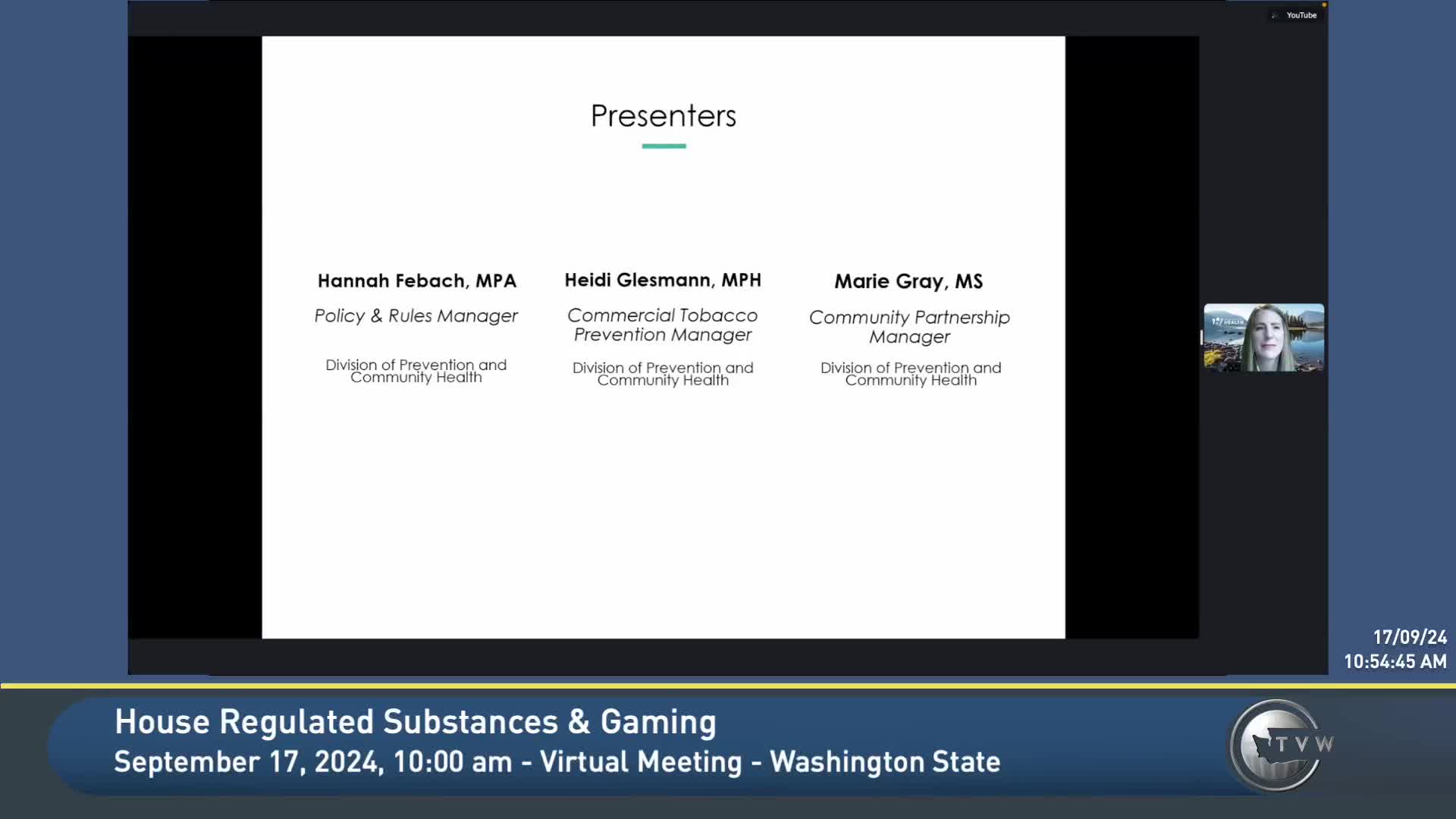State health officials tackle youth cannabis and tobacco crisis
September 17, 2024 | Regulated Substances & Gaming, House of Representatives, Legislative Sessions, Washington
This article was created by AI summarizing key points discussed. AI makes mistakes, so for full details and context, please refer to the video of the full meeting. Please report any errors so we can fix them. Report an error »

During a recent government meeting, officials from the Department of Health presented an overview of their ongoing efforts in cannabis and commercial tobacco prevention, particularly focusing on youth. Hannah Bivak, the policy and rules manager, emphasized the department's commitment to addressing the rising concerns surrounding youth substance use, particularly in light of new data from the 2023 Healthy Youth Survey.
The presentation highlighted that commercial tobacco remains the leading cause of preventable death in the U.S., and the use of nicotine and THC can adversely affect developing brains. Bivak clarified that references to tobacco in their discussions pertain specifically to commercial tobacco, distinguishing it from traditional tobacco, which holds cultural significance for various American Indian tribes.
Heidi Klessman, the commercial tobacco prevention manager, shared insights from the Healthy Youth Survey, noting that cannabis and e-cigarettes are among the top three substances used by 10th graders in Washington state. Alarmingly, smokeless tobacco usage has surged, attributed to a recent modification in survey questions that now include products like nicotine pouches and lozenges. The data revealed significant disparities in substance use among different demographic groups, with American Indian/Alaskan Native and Black/African American youth reporting higher rates of cannabis and tobacco use compared to state averages.
The department's approach includes a focus on prevention and education, particularly through community partnerships and tailored campaigns aimed at high-risk populations. They are also implementing new initiatives, such as a youth prevention campaign called \"Choose You,\" which addresses industry tactics aimed at attracting young users.
Looking ahead, the department plans to enhance its efforts through targeted education on high-potency THC products and continued collaboration with community organizations to address the root causes of substance use disparities. The meeting concluded with discussions on the importance of addressing both youth and adult substance use prevention, highlighting the need for comprehensive strategies to combat illegal use among adolescents.
Overall, the meeting underscored the ongoing challenges and the department's proactive stance in tackling youth substance use through data-driven strategies and community engagement.
The presentation highlighted that commercial tobacco remains the leading cause of preventable death in the U.S., and the use of nicotine and THC can adversely affect developing brains. Bivak clarified that references to tobacco in their discussions pertain specifically to commercial tobacco, distinguishing it from traditional tobacco, which holds cultural significance for various American Indian tribes.
Heidi Klessman, the commercial tobacco prevention manager, shared insights from the Healthy Youth Survey, noting that cannabis and e-cigarettes are among the top three substances used by 10th graders in Washington state. Alarmingly, smokeless tobacco usage has surged, attributed to a recent modification in survey questions that now include products like nicotine pouches and lozenges. The data revealed significant disparities in substance use among different demographic groups, with American Indian/Alaskan Native and Black/African American youth reporting higher rates of cannabis and tobacco use compared to state averages.
The department's approach includes a focus on prevention and education, particularly through community partnerships and tailored campaigns aimed at high-risk populations. They are also implementing new initiatives, such as a youth prevention campaign called \"Choose You,\" which addresses industry tactics aimed at attracting young users.
Looking ahead, the department plans to enhance its efforts through targeted education on high-potency THC products and continued collaboration with community organizations to address the root causes of substance use disparities. The meeting concluded with discussions on the importance of addressing both youth and adult substance use prevention, highlighting the need for comprehensive strategies to combat illegal use among adolescents.
Overall, the meeting underscored the ongoing challenges and the department's proactive stance in tackling youth substance use through data-driven strategies and community engagement.
View full meeting
This article is based on a recent meeting—watch the full video and explore the complete transcript for deeper insights into the discussion.
View full meeting
